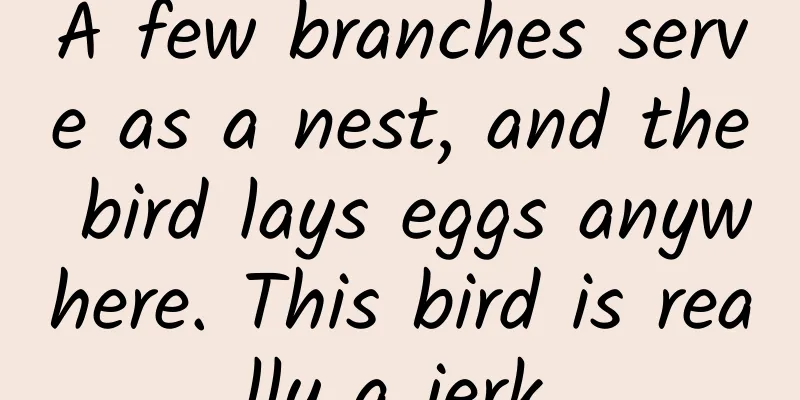A few branches serve as a nest, and the bird lays eggs anywhere. This bird is really a jerk.

|
Some time ago, citizens often shared interesting stories about finding bird nests and bird eggs at home on social platforms. If you have seen this before, you must have admired the greatness and magic of nature. It is unimaginable that there are such sloppy and peculiar nests in the world: A few branches are all the nesting materials. Source: Xiaohongshu netizen The painting style gradually became minimalist Source: Xiaohongshu netizens Is this...really the Bird's Nest? Source: Xiaohongshu netizen The bird's nest has a fixed shape? It doesn't exist! Source: Xiaohongshu netizen The perfunctory master of eggs of all sizes The bird that can build such a casual nest in your home is a bird that is good at making do. It is called the spotted dove (Spilopelia chinensis), which belongs to the family Columbidae in the order Columbiformes. Because it looks similar to a domestic pigeon, it is often called a wild pigeon. From a taxonomic point of view, the two are indeed closely related, and their calls are somewhat similar. Because the spotted dove often makes a cooing sound, coupled with its daily confusing behavior, they are also nicknamed "silly cooing". Turtle Dove: Who is calling me silly? The overall color of the collared dove is pink-brown, with its flight feathers darker than its body color, pink chest and abdomen, red feet, and slightly long tail feathers with white front parts on both sides. The most obvious feature is that the sides of its neck are covered with white spots , as if it is wearing a sparkling pearl necklace, which is also the origin of the "pearl neck". Pearl-necked turtledove wearing a "pearl necklace" | Photo by Zheng Yunxiang If a bird box test is conducted, the spotted dove is definitely an "e bird" (cheerful and sociable). As one of the common birds that is highly adapted to urban life, the spotted dove has adapted to the human living environment in all aspects of life. For example, in addition to finding natural foods such as various plant fruits, seeds, and tender grasses, food scraps left by humans are also easily accessible meals for them. In addition to eating, the turtle dove is even more famous for its shelter. If you type the words "peaceful dove nest" on social software, you will find that this wild bird will build its home anywhere in the residents' homes , such as balconies, flower pots, shoe boxes, and even clothes drying outside... Turtle dove eggs laid in a flower pot Clothes hung outside should be collected promptly, otherwise... It can be produced all year round! If you are curious about why the spotted dove lives such a large family, then you need to study its breeding strategy. Most birds breed 1-2 nests in spring and autumn, but the spotted dove can breed all year round , regardless of the cold or the hot summer. Many birds use spring and summer to breed, which is related to the abundance of insects and other food in spring and summer. However, like other Columbiformes, the spotted dove feeds its chicks with pigeon milk secreted by the crop glands in the first few days after hatching. Pigeon milk is a high-protein food that can help baby birds grow quickly. When they grow older, the parent birds will directly break down the food into a semi-digested state and feed it to their children. Unlike insectivorous birds, they don’t have to worry about not being able to find insects in cold weather. A spotted dove incubating eggs | Photo by Zheng Yunxiang Don't laugh at the minimalist nest of the spotted dove mentioned above, because it contains a lot of wisdom. On the one hand, the structure of the bird's nest is simple, and less materials (or even very little) can reduce the time of nesting and shorten the entire breeding cycle . On the other hand, although the bird's nest is simple, choosing a man-made building as the nesting site can make full use of the structure of the building itself to keep the eggs stable and provide shelter from wind and rain. The flowerpot itself provides enough stability | Source see watermark Another benefit of living around humans is that it reduces the chances of being discovered by predators . For example, predators with an "i" (introverted) personality may simply drool and walk away when they see a spotted dove laying eggs a few meters away from humans. Of course, birds like the kestrel, which are also adapted to urban life, are a different story. Citizens often observe kestrel preying on young spotted doves on the balcony, and the success rate is very high. The kestrel often preys on spotted dove chicks Other Birds That Might Appear on Your Balcony In addition to the nests of spotted doves, some urban birds also build nests in our homes or communities: 1 White-crowned Bulbul ( Pycnonotus sinensis ) The nest of the white-crowned bulbul is more like a work that combines nature and man-made elements. In addition to natural materials such as plant stems and leaves, it also contains many artificial materials such as plastic sheets, fishing lines and cotton wool. It is really highly recognizable. Materials made by humans are also changing the nests of white-crowned bulbuls | Photo by Zheng Yunxiang 2 Blackbird ( Turdus merula ) The blackbird's nest is like a concrete structure in nature, composed of a mixture of water plants and soil. It is sturdy and durable. The blackbird often builds its nest in the fork of branches of tall trees such as camphor. Blackbird's nest at the junction of tree branches | Photo by Zheng Yunxiang 3 House Sparrow ( Passer montanus ) Sparrows' nests are mostly built in the holes left in the outer walls of residential buildings. Whether it is the pipes of the range hood, the reserved electrical wire outlets, etc., they may attract sparrows to build their nests. Sparrow's nest on the outer wall of a house | Photo: Zheng Yunxiang 4 Hoopoe ( Upupa epops ) Hoopoe also often visits the community where we live. It mainly uses natural tree holes to build nests, but suitable tree holes in nature are not so easy to find, so the hoopoe has also turned its attention to human buildings. Some pipes are good nesting places, and some parks will also build artificial nests specifically for hoopoes. In nature, hoopoes build nests in holes in trees. Photography: Zheng Yunxiang I found a bird's nest in my home, what should I do? When you accidentally find a bird's nest at home, don't be surprised. Please stay calm and don't shout and scare the bird. Please treat these natural elves, who may be interesting, smart, or slightly clumsy, well. Do not disturb their reproduction, feed them, or add decorations to their nests. Their breeding period is not too long, so you can observe and record them quietly. I believe you can also see and discover more natural mysteries from them. Amid the skyscrapers, these birds have been learning how to share nature with humans. Isn’t it beautiful that we can observe these species that are older than us on Earth performing stories of survival wherever we look? Planning and production Source: Shanghai Natural History Museum Author: Zheng Yunxiang, Engineer, Shanghai Forestry General Station Review|He Xin, Associate Researcher, Shanghai Natural History Museum Editor: Yang Yaping Proofread by Xu Lai and Lin Lin |
<<: How to get the flu vaccine this year? All your questions are here
Recommend
Teacher Chen Longjuan Nanxi Youth Emotional Education Training Camp
Course Catalog 00.Opening Ceremony.mp4 01.Scienti...
APP review was rejected due to these 10 reasons!
Recently, Apple listed the top ten reasons for ap...
How to operate self-media content? 3 tips!
All products must contain content, from as small ...
Prediction of the impact of the epidemic on housing prices in 2020. Will housing prices fall after the 2020 epidemic?
Now is the epidemic period, but there is still a ...
Analysis of advertising video materials!
In recent years, with the increasing demand of th...
Toutiao Baijia Sohu Netease Penguin Yidian Zixun Six major self-media account operation methods
In recent years, the advantages of old media have...
How much does it cost to make a fruit and vegetable app? How much does it cost to make a small program?
How much does it cost to make a fruit and vegetab...
The latest blockbuster of a famous actress has caused controversy, and netizens exclaimed: This flower is poisonous!
recently A group of magazine photos of actress Su...
Top 10 Brand Marketing Trends in 2022
Last Sunday, we discussed with our friends on “Br...
After a successful launch, where does the rocket's final stage go?
"10, 9, 8, 7, 6, 5, 4, 3, 2, 1, ignition&quo...
Wuhuang Bazhahei: Wow! They said they could “pick down” the moon for us to see?
The most romantic dream is nothing more than &quo...
How to Recall Lost Users: How to Use SMS to Draw Customers!
The uninstall volume of most apps is increasing, ...
BAIC New Energy and Magna to establish joint venture to produce high-end electric vehicles
On June 18, Beijing New Energy Automobile Co., Lt...
Three popular science editors carefully analyzed Zibo barbecue and discovered the secret of its fire
Audit expert: Taozi National Psychological Counse...
Is the smart bracelet just a transitional product?
Estimated global shipments of wearable electronic...






![[Li Jiaoshou] Why does it get worse the more we learn marketing from big brands?](/upload/images/67cc19637c62a.webp)


